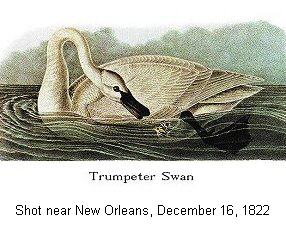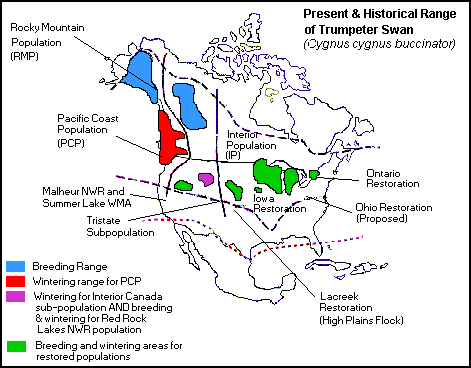 A once nearly extinct Trumpeter Swan has been seen near the Moody Bridge in Tupper Lake. First sighted on Monday March 20th by Charlcie Delahanty, the bird has been seen several times over the last week. According to the Trumpeter Swan Society, this is North America’s largest waterfowl and one of our rarest native birds. Nearly lost to hunting and habitat loss, the Trumpeter Swan has made a comeback but still have not returned to much of their traditional range. The big news is that the Adirondacks is not this swan’s typical range.
A once nearly extinct Trumpeter Swan has been seen near the Moody Bridge in Tupper Lake. First sighted on Monday March 20th by Charlcie Delahanty, the bird has been seen several times over the last week. According to the Trumpeter Swan Society, this is North America’s largest waterfowl and one of our rarest native birds. Nearly lost to hunting and habitat loss, the Trumpeter Swan has made a comeback but still have not returned to much of their traditional range. The big news is that the Adirondacks is not this swan’s typical range.

I wasn’t kidding, this Swan has a wingspan of 2.5 meters – that’s 8.2 feet. That’s some serious flapping action and can propel this swan up to almost 50 mph. According to Audubon “It measured nearly ten feet in alar extent, and weighed above thirty-eight pounds.” Audubon goes on with this interesting tidbit:
If the morning proved fair, the flocks would rise on their feet, trim their plumage, and as they started with wings extended, as if racing in rivalry, the pattering of their feet would come on the ear like the noise of great muffled drums, accompanied by the loud and clear sounds of their voice. On running fifty yards or so to windward, they would all be on wing. If the weather was thick, drizzly, and cold, or if there were indications of a fall of snow, they would remain on the ice, walking, standing, or lying down, until symptoms of better weather became apparent, when they would all start off. One morning of this latter kind, our men formed a plot against the Swans, and having separated into two parties, one above, the other below them on the ice, they walked slowly, on a signal being given from the camp, toward the unsuspecting birds. Until the boatmen had arrived within a hundred and fifty yards of them, the Swans remained as they were, having become, as it would appear, acquainted with us, in consequence of our frequently crossing the ice; but then they all rose on their feet, stretched their necks, shook their heads, and manifested strong symptoms of apprehension. The gunners meanwhile advanced, and one of the guns going off by accident, the Swans were thrown into confusion, and scampering off in various directions took to wing, some flying up, some down the stream, others making directly toward the shores. The muskets now blazed, and about a dozen were felled, some crippled, others quite dead. That evening they alighted about a mile above the camp, and we never went after them again. I have been at the killing of several of these Swans, and I can assure you that unless you have a good gun well loaded with large buck-shot, you may shoot at them without much effect, for they are strong and tough birds.
The Audubon Society Trumpeter Swan page list the top threat to this swan is human encroachment. Ironic huh? I never knew what Audubon was, but now I learn it is actually a person. Very good reading. I’ll bet that guy that shot his gun early got some grief from his fellow hunters back at camp. He goes on with some excellent observations and finishes with this excellent culinary tip, “The flesh of a cygnet is pretty good eating, but that of an old bird is dry and tough.” And this :
I kept a male alive upwards of two years, while I was residing at Henderson in Kentucky. It had been slightly wounded in the tip of the wing, and was caught after a long pursuit in a pond from which it could not escape. Its size, weight, and strength rendered the task of carrying it nearly two miles by no means easy; but as I knew that it would please my wife and my then very young children, I persevered. Cutting off the tip of the wounded wing, I turned it loose in the garden. Although at first extremely shy, it gradually became accustomed to the servants, who fed it abundantly, and at length proved so gentle as to come to my wife’s call, to receive bread from her hand. “Trumpeter,” as we named our bird, in accordance with the general practice of those who were in the habit of shooting this species, now assumed a character which until then had been unexpected, and laying aside his timidity became so bold at times as to give chase to my favourite Wild Turkey Cock, my dogs, children, and servants. Whenever the gates of our yard happened to be opened, he would at once make for the Ohio, and it was not without difficulty that he was driven home again. On one occasion, he was absent a whole night, and I thought he had fairly left us; but intimation came of his having travelled to a pond not far distant. Accompanied by my miller and six or seven of my servants, I betook myself to the pond, and there saw our Swan swimming buoyantly about as if in defiance of us all. It was not without a great deal of trouble that we at length succeeded in driving it ashore. Pet birds, good reader, no matter of what species they are, seldom pass their lives in accordance with the wishes of their possessors; in the course of a dark and rainy night, one of the servants having left the gate open, Trumpeter made his escape, and was never again heard of.
I love this guy. It sure seems that birdwatching was a whole different kind of activity back in the old days. Anyway, back to our Adirondack Swan. It was first spotted by a local birder who has been birding since the 60’s. She rates this sighting just shy of some Grebe she saw. You can listen to her interview below and see some pics of the Adirondack Swan.
More Information:
Photos taken on March 21, 2006 Tom Dudones Saranac Lake
Brian Mann’s Interview with Charlcie Delehanty (mp3) North Country Public Radio
John J. Audubon on the Trumpeter Swan – Buy
Trumpeter Swan Cornell Lab of Ornithology







No Comments so far ↓
There are no comments yet...